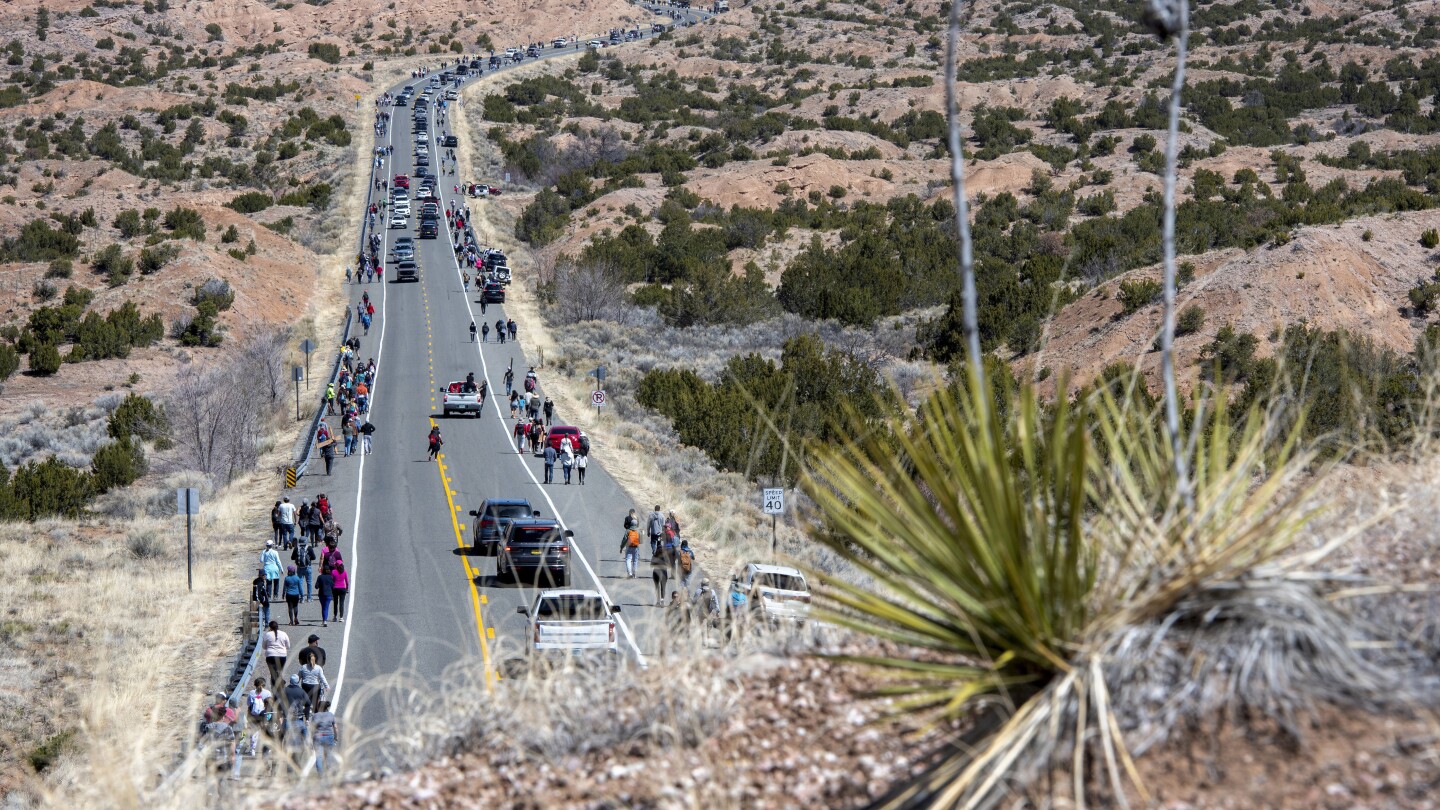Lifestyle
One Tech Tip: Locking down your device when crossing borders

LONDON (AP) — Planning an international trip? Travelers should prepare for the possibility of extra scrutiny of their phones when crossing borders, especially when entering the United States.
The Canadian government warned travelers in a recent travel advisory that U.S. border agents are entitled to search your electronic devices and “don’t need to provide a reason when requesting a password to open your device.”
Some recent cases have made travelers nervous about their privacy, such as when a Brown University professor with a U.S. visa was deported to Lebanon after border agents found a photo of Hezbollah’s leader on her phone.
“While 100% privacy may be impossible in these situations, there are a few things you can easily do that make it much harder for someone to see your private data even with physical access to your device,” said Patricia Egger, head of security at encrypted service Proton Mail.
Here are tips on protecting your device privacy while travelling:
What should I do before I set off?
Experts say the best strategy is to reduce the amount of information you’re carrying while traveling.
If possible, leave your phone at home. If you need one on your trip, borrow a tactic used by corporate executives looking to avoid hackers: get a temporary or “burner” device. It can contain just the information you need for your trip. Download anything else from the cloud when you need it.
If you have to bring your phone or laptop, upload sensitive information to a cloud storage service that uses end-to-end encryption, then delete the originals from your device.
Also, encrypt your phone or laptop’s storage drive and protect it with a strong password. Be aware this is different from merely having a device passcode lock, which is more easily cracked, or the end-to-end encryption on your favorite communication platforms.
Turn off fingerprint or facial recognition features and use the PIN or passcode instead.
What kind of search will be done at borders?
There are two kinds of searches, according to the U.S. Customs and Border Protection website.
In a basic search, an officer scrolls through your phone’s photos, emails, apps and files. No suspicion of wrongdoing is needed to conduct this type of search.
In an advanced search, the contents of your device could be copied for analysis. But a senior manager needs to sign off and there needs to be “reasonable suspicion” of a legal violation, except if there’s any concern for national security, according to the Electronic Frontier Foundation (EFF).
Who’s at risk of getting searched and what are they looking for?
“It’s hard to say,” says Sophia Cope, senior staff attorney at the EFF, which offers an extensive online guide to border privacy. Warrants are not needed to inspect devices belonging to anyone entering the country.
U.S. Customs and Border Protection agents carried out a total of more than 47,000 electronic device searches last year, up tenfold from a decade ago.
Basic searches “can be for no reason at all, totally random, or based on a mere hunch about someone – maybe based on how they look or an answer they gave to a preliminary question,” said Cope.
Travel history can also be relevant, for example, if a traveler originates from someplace where terrorism, drug trafficking, or child sex tourism is common, she said. Border agents can also search devices “at the behest” of other agencies like the FBI or if they’re associated with someone else of interest, such as a journalist’s source, a business associate or a family member.
What should I do when I get to the border?
Best to power off your devices when you touch down.
Under current policy, U.S. border agents are only allowed to look at information stored on the device, and not anything that’s kept in the cloud. So if you have to leave your phone on, make sure it’s kept in airplane mode or otherwise disconnected from the internet by Wi-Fi or cellular data.
“Before crossing the border, put your device in airplane mode to ensure remote files don’t get downloaded accidentally,” the Canadian government warns.
But keep in mind there might be cached data that still remains on your phone, such as files in the trash that haven’t been emptied.
What if I refuse?
American citizens can’t be denied entry to the United States for refusing to consent to device searches. The same should apply to lawful permanent residents such as green card holders, the American Civil Liberties Union says.
But agents can make things difficult if they’re refused. Travelers could be questioned, detained temporarily or have their devices seized and not returned for days or even weeks, rights groups say.
Foreign travelers could be turned back if they say no.
If you’re forced to unlock your device, Egger advises that “where you can, log in yourself rather than divulging any PINs or passwords, and if forced to share passwords, change them as soon as you can.”
Experts say the reason you should not use your device’s fingerprint or facial recognition feature is that it’s easier to compel you to unlock your device with biometrics. A border agent could simply hold your phone up to your face or force you to press your finger onto your device. There are also fears that police could use fingerprints stored on government databases.
Powering off your devices is another way to protect against sophisticated attacks in case you don’t consent to a search.
Most modern phones and some laptops encrypt their data using a strong cryptographic keys only accessible when the user unlocks it with the passcode, said Will Greenberg, the EFF’s senior staff technologist.
If the device is locked but not turned off, the key remains loaded on the device’s memory. Powerful hacking tools made by companies like Cellebrite can recover the key and decipher the data.
But if the device is off, the key is unloaded and can’t be accessed until it’s turned on again and unlocked with the passcode.
“This is why a border agent can’t simply turn a device on to use a tool like Cellebrite,” Greenberg said.
What about social media?
To be on the safe side, delete your social media apps and reinstall them later. Even though content is mainly stored on a social media company’s servers, Cope says some posts or images might remain on your phone’s memory cache and therefore viewable even in airplane mode.
What else can be searched?
It’s not just phones and laptops. Digital cameras, smartwatches, tablets, external hard drives and other electronic devices can be searched.
What not to do?
Some tactics might backfire. If you’re tempted to completely wipe your phone or laptop hard drive before you travel, experts warn it could raise scrutiny.
“If detected by a border agent, the fact that you wiped your hard drive may prompt the agent to ask why you did so,” the EFF’s guide says. “Even traveling without devices or data that most travelers typically have could attract suspicion and questions.”
Also don’t try to hide information on your device, because border agents could find out, the group says. “Lying to border agents can be a serious crime, and the agents may take a very broad view of what constitutes lying,” it says.
What about other destinations?
Check local laws of your destination before you travel. For example, Britain’s counterterrorism law allows police to demand that people passing through the country’s border hand over devices along with passwords and PINs. If they refuse, they can be charged with terrorism.
___
Is there a tech topic that you think needs explaining? Write to us at [email protected] with your suggestions for future editions of One Tech Tip.
Lifestyle
Look inside Maine’s ‘Sistine Chapel’ with 70-year-old frescoes

SOLON, Maine (AP) — From the outside, it looks like any other New England church building: a boxy, white structure with a single steeple surrounded by an old stone wall, set against rolling hills and pine forest.
Inside, though, the South Solon Meeting House has a secret unknown even to some who drive through the tiny Maine town every day. The interior of the building is covered in 70-year-old fresco murals that encourage some in the state’s art community to describe it as “Maine’s Sistine Chapel.”
The murals were painted by artists in the 1950s and, while they have long been appreciated by visitors, the recent creation of a website dedicated to them by students at Colby College in Waterville, Maine, has generated new interest in the paintings.
Véronique Plesch, a Colby professor of art, hopes the building inspires more appreciation of frescoes.
“I fell in love with the place, because I have studies frescoes all my life,” said Plesch, who is a member of the board of the historical society that cares for the meeting house. She added that the paintings should stay in public places and not be in private institutions.
The meeting house was built in 1842 and hosted church services until the 1940s, though there were periods of closure, such as times of war. A decade later, Margaret Day Blake found the building in a state of disuse and the former student at the nearby Skowhegan School of Painting and Sculpture put out a call for young artists to paint frescoes under the school’s supervision in 1951.
The artists were given creative freedom and told there would be no limits to subject matter, but that Biblical scenes would “offer rich and suitable” imagery. The interior was covered in such scenes from 1952 to 1956 and the walls remain adorned with frescoes, including one that references Leonardo da Vinci’s “The Last Supper.”
Another fresco depicts the binding of Isaac, in which a hooded Abraham prepares to sacrifice his son on God’s orders. The Great Flood is depicted as it was by Michelangelo at the Sistine Chapel at the Vatican.
Two of the 13 artists — Sigmund Abeles of New York City and Sidney Hurwitz of Newton, Massachusetts — both in their 90s, are still living. Both spoke fondly about their time at the meeting house.
“We would go out there and paint and then take a lunch break in the cemetery behind the building. It was a very idyllic time,” Hurwitz said. “I very much enjoyed it.”
Today, the meeting house, which is open to the public without locks on its doors, serves as a community gathering and performance space. Many of its old features, including box pews made for smaller people of a different time, are still intact.
Abeles recalled painting the scene of Jacob wrestling with the angel from the Book of Genesis.
“It’s a very, very special place, and it was a unique experience” to work on the frescoes, Abeles said.
On a recent Sunday morning, Plesch gave a lecture at the meeting house before a group of members of the Maine Art Education Association as part of the group’s spring conference. Long ago, attendants of the building might have been preparing for an Easter service, but on this day it was full of teachers fascinated by the frescoes.
Suzanne Goulet, an art teacher at a nearby high school, said she was previously aware of the frescoes and confessed she had peaked into the windows of the old building, adding that it’s great the paintings are still inspiring art lovers decades later.
“The inspiration is that we bring it back to our students,” Goulet said.
Lifestyle
Thousands of pilgrims trek through New Mexico desert to historic adobe church for Good Friday

SANTA FE, N.M. (AP) — A unique Holy Week tradition is drawing thousands of Catholic pilgrims to a small adobe church in the hills of northern New Mexico, in a journey on foot through desert badlands to reach a spiritual wellspring.
For generations, people of the Upper Rio Grande Valley and beyond have walked to reach El Santuario de Chimayó to commemorate Good Friday.
Pilgrims, some walking for days, were on track to arrive Friday amid a forecast of cool temperatures and sprinkles of rain.
Some travelers are lured by an indoor well of dirt believed to have curative powers. Throughout the year, they leave behind crutches, braces and canes in acts of prayer for infirm children and others, and as evidence that miracles happen.
Easter week visitors file through an adobe archway and narrow indoor passages to find a crucified Nuestro Señor de Esquipulas at the main altar. According to local lore, the crucifix was found on the site in the early 1800s, a continent away from its analog at a basilica in the Guatemalan town of Esquipulas.
A spiritual place
Chimayó, known for its artisan weavings and chile crops, rests high above the Rio Grande Valley and opposite the national defense laboratory at Los Alamos that sprang up in the race to develop the first atomic weapon.
The iconic adobe church at Chimayó was cast from local mud at the sunset of Spanish rule in the Americas in the early 1800s, on a site already held sacred by Native Americans.
Set amid narrow streets, curio shops and brooks that flow quickly in spring, El Santuario de Chimayó has been designated as a National Historic Landmark that includes examples of 19th century Hispanic folk art, religious frescoes and saints carved from wood known as bultos.
One votive room is filled with notes of thanks from those who say they had ailments cured.
A separate chapel is dedicated to the Santo Niño de Atocha, a patron saint of children, travelers and those seeking liberation and a fitting figure of devotion for Chimayó pilgrims on the go.
Hundreds of children’s shoes have been left in a prayer room there by the faithful in tribute to the holy child who wears out footwear on miraculous errands. There are even tiny boots tacked to the ceiling.
Pueblo people who inhabited the Chimayó area long before Spanish settlers believed healing spirits could be found in the form of hot springs. Those springs ultimately dried up, leaving behind earth attributed with healing powers.
A way of life
Photographer Miguel Gandert grew up in the Española valley below Chimayó and made the pilgrimage as a boy with his parents.
“Everybody went to Chimayó. You didn’t have to be Catholic,” said Gandert, who was among those who photographed the 1996 pilgrimage through a federal grant. “People just went there because it was a powerful, spiritual place.”
Scenes from that pilgrimage — on display at the New Mexico History Museum in Santa Fe — include children eating snow cones to keep cool, men shouldering large wooden crosses, infants swaddled in blankets, bikers in leather and weary pedestrians resting on highway guardrails to smoke.
A generation later, Good Friday pilgrims still haul crosses on the road to Chimayó, as families leave behind cars, push strollers and allow time for older hikers. Throngs of visitors often wait hours for a turn to file into the Santuario de Chimayó to commemorate the crucifixion.
It’s just one of hundreds of adobe churches anchoring a uniquely New Mexican way of life for their communities. Many are at risk of crumbling into the ground in disrepair as congregations and traditions fade.
A journey on foot
Pilgrims from nearby towns set out for Chimayó in the predawn hours. Some have walked 20 miles (32 kilometers) from Santa Fe, while others traveled for days from Albuquerque and elsewhere.
Vendors sell religious trinkets, coffee and treats. State transportation workers, law enforcement agencies and other volunteers are stationed along the roadway to ensure safety from oncoming traffic, the outdoor elements and exhaustion.
Pilgrims traverse an arid landscape speckled with juniper and piñon trees and cholla cactus that finally give way to lush cottonwood trees and green pastures on the final descent into Chimayó.
The magnitude of the religious pilgrimage has few if any rivals in the U.S. Many participants say their thoughts dwell not only on Jesus Christ but on the suffering of family, friends and neighbors with prayers for relief.
___
Associated Press religion coverage receives support through the AP’s collaboration with The Conversation US, with funding from Lilly Endowment Inc. The AP is solely responsible for this content.
Lifestyle
Ralph Lauren stays closer to home this time with intimate Manhattan gallery show

NEW YORK (AP) — Ralph Lauren, known for staging elaborate runway shows in sumptuous settings like the horsey Hamptons or amid his vintage car collection, took it down a notch for a more intimate show Thursday in a Manhattan gallery space.
As celebrities like Anne Hathaway, Michelle Williams, Julia Louis-Dreyfus, Ariana DeBose and many others watched from the front row, Lauren presented a fall collection dubbed “The Modern Romantics,” heavy on high ruffled necks, classics like buttery leather in everything from aviator jackets to bustiers, and soft cashmere. Evening looks were long and lacy.
Models descended a grand staircase in an airy gallery setting
Lauren’s models first appeared atop a balcony, then each descended a grand staircase to walk the runway. The venue, now the Jack Shainman Gallery, was built in 1898 in the Italian Renaissance Revival style.
For the New York-based crowd, it was much less of a journey than Lauren’s last show in the Hamptons on Long Island, which took some guests four hours from Manhattan in busy traffic.
Lauren himself appeared at the end of the show to wave — from the top of the balcony.
A romantic theme
Lauren said he was celebrating “The Modern Romantics,” an aesthetic he described as “self-assured and unbound by rules.”
Strutting the runway, the models displayed looks that began with a classic Lauren combination of black trousers, a high-necked ruffled white shirt, and an aviator jacket in brown distressed leather.
That was followed by a filmy white midi-dress paired with a thick black leather belt, and tall black leather boots.
A black leather bustier was paired with a long camel wool skirt, and white lacy ruffled shirts popped up in different ensembles — with a long camel coat, or a puffy brown cardigan. There were also white lace neckties. There were velvet jackets, including in a deep shade of purple.
Outfits segued into evening with long, silky or strappy gowns, one in a white crochet theme, another in sumptuous black lace. There was a black halter gown in tiers of ruffles spiraling around the body.
Celebs in attendance
Hathaway, Williams and Watts sat together in the front row, each in a Lauren-style trench or wrap coat. Hathaway, her hair pulled back in a tight ponytail, paired her coat with a pair of tan-colored jeans, embroidered with sequins and strategically shredded.
DeBose wore a smart gray suit that would go perfectly with next month’s Met Gala dress code: “Tailored For You.” Louis-Dreyfus wore a cropped leather jacket in light brown, with white trousers.
Also attending were Sadie Sink, Sarah Catherine Hook, Eiza Gonzalez, Andra Day, Kacey Musgraves and Ella Hunt, among others.
Seen and heard at Lauren’s show
“I thought it was very much his sensibility and what he believes,” Anna Wintour, the influential Vogue editor, said after the show, noting that Lauren’s fashion transcended trends. “He’s a designer that never looks to the left or to the right. He’s just very clear in what he wants to say and what his customer wants, and that’s one of the reasons he’s so unbelievably successful.”
Sarah Catherine Hook, who appeared in the recently concluded third season of “The White Lotus,” said she liked the collection’s ephemeral feel.
“I love anything timeless and I feel like this is the most timeless you could possibly get,” Hook said. “I love the masculine-feminine mix of it and this is my first time getting to wear a necktie, so I’m feeling pretty chic today.”
-

 Conflict Zones2 days ago
Conflict Zones2 days agoAfter two years of war in Sudan, the world can no longer plead ignorance | Conflict
-

 Education2 days ago
Education2 days agoTrump administration revokes humanitarian parole of Spanish teacher
-

 Europe2 days ago
Europe2 days agoCody Balmer, the suspect in arson at Pennsylvania governor’s home targeted the governor for his views on war in Gaza, warrant says
-

 Europe2 days ago
Europe2 days agoPolice arrest couple for breeding and selling exotic cats in Spain
-

 Conflict Zones2 days ago
Conflict Zones2 days agoIsraeli soldiers filmed themselves destroying Gaza: See the video evidence | Israel-Palestine conflict News
-

 Sports2 days ago
Sports2 days agoStephen Curry and Jimmy Butler lift the Warriors past the Grizzlies and into the NBA Playoffs
-

 Conflict Zones16 hours ago
Conflict Zones16 hours agoHaiti in ‘free fall’ as violence escalates, rights group warns | Armed Groups News
-

 Africa2 days ago
Africa2 days agoSudan: Rapid Support Forces leader announces rival government




